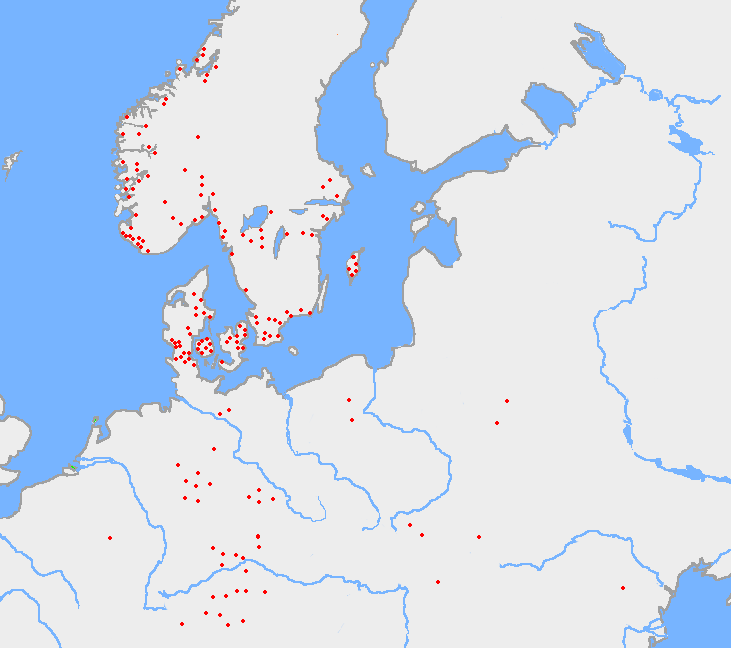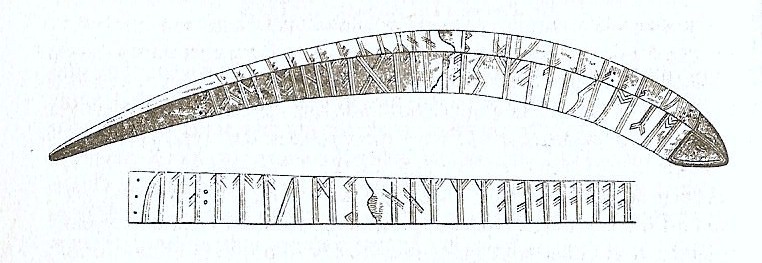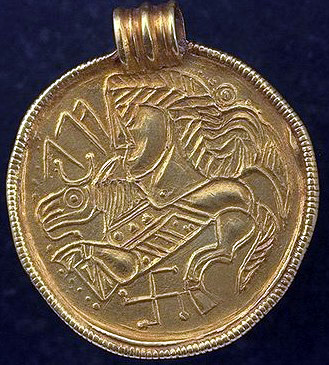|
Östergötland Runic Inscription 43
Östergötland Runic Inscription 43 or Ög 43 is the Rundata catalog number for a Viking Age runic inscription carved on a rockface in Ingelstad, just north of Norrköping, Östergötland, Sweden. Description Ög 43 is carved on a granite rockface consisting of two lines of text within runic text bars that are approximately 0.4 meters in length. Above it is carved a sword, and a cross and Nordic sun symbol are also carved nearby. The runic text is in the younger futhark except for the first rune in the second line, which uses the form of the d-rune, , from the elder futhark. p. 451. The Rök runestone, dated to this same period, also mixes runes from both futharks in its inscription. Because of this, it has been dated to approximately 850 C.E. The association of the carving of a sun with the word ''sól'' along with the use of an anachronistic d-rune may suggest it is a ritualistic comparison of the dim winter sun and the bright summer sun, and represents a runic magic call for ... [...More Info...] [...Related Items...] OR: [Wikipedia] [Google] [Baidu] |
Elder Futhark
The Elder Futhark (or FuĂľark, ), also known as the Older Futhark, Old Futhark, or Germanic Futhark, is the oldest form of the runic alphabets. It was a writing system used by Germanic peoples for Northwest Germanic dialects in the Migration Period. Inscriptions are found on artifacts including jewelry, amulets, plateware, tools, and weapons, as well as runestones, from the 2nd to the 8th centuries. In Scandinavia, beginning in the late 8th century, the script was simplified to the Younger Futhark, while the Anglo-Saxons and Frisians instead extended it, giving rise to the Anglo-Saxon runes, Anglo-Saxon futhorc. Both the Anglo-Saxon futhorc and the Younger Futhark remained in use during the Early Middle Ages, Early and the High Middle Ages respectively, but knowledge of how to read the Elder Futhark was forgotten until 1865, when it was deciphered by Norwegian scholar Sophus Bugge. Description The Elder Futhark is named after the initial phoneme of the first six rune names: /f/ ... [...More Info...] [...Related Items...] OR: [Wikipedia] [Google] [Baidu] |
Runestones In Östergötland
A runestone is typically a raised stone with a runic inscription, but the term can also be applied to inscriptions on boulders and on bedrock. The tradition of erecting runestones as a memorial to dead men began in the 4th century and lasted into the 12th century, but the majority of the extant runestones date from the late Viking Age. While most of these are located in Scandinavia, particularly Sweden, there are also scattered runestones in locations that were visited by Norsemen. Runestones were usually brightly coloured when erected, though this is no longer evident as the colour has worn off. History The tradition of raising stones that had runic inscriptions first appeared in the 4th and 5th century, in Norway and Sweden, and these early runestones were usually placed next to graves, though their precise function as commemorative monuments has been questioned. The earliest Danish runestones appeared in the 8th and 9th centuries, and there are about 50 runestones from the Mi ... [...More Info...] [...Related Items...] OR: [Wikipedia] [Google] [Baidu] |
Norse Mythology
Norse, Nordic, or Scandinavian mythology, is the body of myths belonging to the North Germanic peoples, stemming from Old Norse religion and continuing after the Christianization of Scandinavia as the Nordic folklore of the modern period. The North Germanic languages, northernmost extension of Germanic mythology and stemming from Proto-Germanic folklore, Norse mythology consists of tales of various deities, beings, and heroes derived from numerous sources from both before and after the pagan period, including medieval manuscripts, archaeological representations, and folk tradition. The source texts mention numerous gods such as the thunder-god Thor, the Huginn and Muninn, raven-flanked god Odin, the goddess Freyja, and List of Germanic deities, numerous other deities. Most of the surviving mythology centers on the plights of the gods and their interaction with several other beings, such as humanity and the jötnar, beings who may be friends, lovers, foes, or family members of ... [...More Info...] [...Related Items...] OR: [Wikipedia] [Google] [Baidu] |
Dagr
Dagr (Old Norse 'day')Lindow (2001:91). is the divine personification of the day in Norse mythology. He appears in the ''Poetic Edda'', compiled in the 13th century from earlier traditional sources, and the ''Prose Edda'', written in the 13th century by Snorri Sturluson. In both sources, Dagr is stated to be the son of the god Dellingr and is associated with the bright-maned horse Skinfaxi, who "draw day to mankind". Depending on manuscript variation, the ''Prose Edda'' adds that Dagr is either Dellingr's son by Nótt, the personified night, or Jörð, the personified Earth. Otherwise, Dagr appears as a common noun simply meaning "day" throughout Old Norse works. Connections have been proposed between Dagr and other similarly named figures in Germanic mythology. Eddaic Dagr ''Poetic Edda'' Dagr is mentioned in stanzas 12 and 25 of the poem '' Vafþrúðnismál''. In stanza 24, the god Odin (disguised as " Gagnráðr") asks the jötunn Vafþrúðnir from where the day comes, ... [...More Info...] [...Related Items...] OR: [Wikipedia] [Google] [Baidu] |
Bjärby Runestones
The Bjärby Runestones are two Viking Age memorial runestones located near Grästorp, Sweden, in Bjärby synod, which was in the historic province of Västergötland. The two stones are memorials to men who held the titles thegn and drengr, and one has a depiction of the hammer of the Norse paganism, Norse pagan deity Thor. Vg 113 Västergötland Runic Inscription 113 or Vg 113 is the Rundata listing for a runestone located in Lärkegapet, which is about one-half kilometer east of Grästorp The inscription, which is on a gneiss stone that is 2.5 meters in height, consists of two vertical bands of runic text with the sides of the runic bands forming the handle of a hammer, which is considered to be a depiction of Thor's hammer Mjöllnir. Because of the length of the text bands, the hammer has a long shaft with the head located at the top of the stone. Thor's hammer was used on several memorial runestones in Sweden and Denmark, perhaps as a parallel to or a Norse paganism, pagan rea ... [...More Info...] [...Related Items...] OR: [Wikipedia] [Google] [Baidu] |
Ideographic Rune
Ideographic runes (, , 'term/notion runes') are runes used as ideographs instead of regular letters, that is, instead of representing their phoneme or syllable, they represent their name as a word or term. Such instances are sometimes referred to by way of the modern German loanword (singular ), but the descriptive term "ideographic runes" is also used. Ideographic runes appears to have mainly been used for saving space, but they were also mainly used without inflection. Some potential inscriptions might have used such cryptically. The criteria for the use of ideographic runes and the frequency of their use by ancient rune-writers remains controversial.See discussion in for example : 123–124 and : 17. The topic of has produced much discussion among runologists. Runologist Klaus Düwel has proposed two criteria for the identification of ideographic runes: A graphic argument and a semantic argument. Roman Iron Age (c. 1–350 AD) One of the earliest potential ideographic rune f ... [...More Info...] [...Related Items...] OR: [Wikipedia] [Google] [Baidu] |
Old Norse
Old Norse, also referred to as Old Nordic or Old Scandinavian, was a stage of development of North Germanic languages, North Germanic dialects before their final divergence into separate Nordic languages. Old Norse was spoken by inhabitants of Scandinavia and their Viking expansion, overseas settlements and chronologically coincides with the Viking Age, the Christianization of Scandinavia, and the consolidation of Scandinavian kingdoms from about the 8th to the 15th centuries. The Proto-Norse language developed into Old Norse by the 8th century, and Old Norse began to develop into the modern North Germanic languages in the mid- to late 14th century, ending the language phase known as Old Norse. These dates, however, are not precise, since written Old Norse is found well into the 15th century. Old Norse was divided into three dialects: Old West Norse (Old West Nordic, often referred to as ''Old Norse''), Old East Norse (Old East Nordic), and Old Gutnish. Old West Norse and O ... [...More Info...] [...Related Items...] OR: [Wikipedia] [Google] [Baidu] |
Runic Magic
There is some evidence that, in addition to being a writing system, runes historically served purposes of magic. This is the case from the earliest epigraphic evidence of the Roman to the Germanic Iron Age, with non-linguistic inscriptions and the '' alu'' word. An '' erilaz'' appears to have been a person versed in runes, including their magic applications. In medieval sources, notably the Poetic Edda, the '' SigrdrĂfumál'' mentions "victory runes" to be carved on a sword, "some on the grasp and some on the inlay, and name Tyr twice." In the early modern period and modern history, related folklore and superstition is recorded in the form of the Icelandic magical staves. In the early 20th century, Germanic mysticism coined new forms of "runic magic", some of which were continued or developed further by contemporary adherents of Germanic Neopaganism. Modern systems of runic divination are based on Hermeticism, classical occultism, and the ''I Ching''. Historical evidence ... [...More Info...] [...Related Items...] OR: [Wikipedia] [Google] [Baidu] |
Rök Runestone
The Rök runestone (; Rundata, Ög 136) is one of the most famous runestones, featuring the longest known runic alphabet, runic inscription in stone. It can now be seen beside the church in Rök, Ödeshög Municipality, Östergötland, Sweden. It is considered the first known piece of written Swedish literature and thus it marks the beginning of the history of Swedish literature.Gustafson, Alrik, Svenska litteraturens historia, 2 volums (Stockholm, 1963). First published as A History of Swedish Literature (American-Scandinavian Foundation, 1961). Chapter 1. About the stone The , tall stone was discovered built into the wall of a church in the 19th century and removed from the church wall a few decades later. The church was built in the 12th century, and it was common to use rune stones as building material for churches. The stone was probably carved in the early 9th century, judging from the main runic alphabet used ("short-twig" runes) and the form of the language. It is cove ... [...More Info...] [...Related Items...] OR: [Wikipedia] [Google] [Baidu] |
Runic Letter Dagaz
Runes are the Letter (alphabet), letters in a set of related alphabets, known as runic rows, runic alphabets or futharks (also, see ''#Futharks, futhark'' vs ''#Runic alphabets, runic alphabet''), native to the Germanic peoples. Runes were primarily used to represent a sound value (a phoneme) but they were also used to represent the concepts after which they are named (ideographic runes). Runology is the academic study of the runic alphabets, runic inscriptions, runestones, and their history. Runology forms a specialised branch of Germanic philology. The earliest secure runic inscriptions date from at latest AD 150, with a possible earlier inscription dating to AD 50 and Tacitus's possible description of rune use from around AD 98. The Svingerud Runestone dates from between AD 1 and 250. Runes were generally replaced by the Latin alphabet as the cultures that had used runes underwent Christianisation, by approximately AD 700 in central Europe and 1100 in northern Europe. Ho ... [...More Info...] [...Related Items...] OR: [Wikipedia] [Google] [Baidu] |
Rundata
The Scandinavian Runic-text Database () is a project involving the creation and maintenance of a database of transliterated runic inscriptions. The project's goal is to comprehensively catalog runestones in a machine-readable way for future research. The database is freely available via the Internet with a client program, called Rundata, for Microsoft Windows. For other operating systems, text files are provided or a web browser can be used to interact with the web applicatioRunor History The origin of the Rundata project was a 1986 database of Swedish inscriptions at Uppsala University for use in the Scandinavian Languages Department. At an international runic seminar in 1990, it was proposed to expand the database to cover all Nordic runic inscriptions, but funding for the project was not available until a grant was received in 1992 from the ''Axel och Margaret Ax:son Johnsons'' foundation. The project officially started on January 1, 1993 at Uppsala University. After 1997, th ... [...More Info...] [...Related Items...] OR: [Wikipedia] [Google] [Baidu] |






